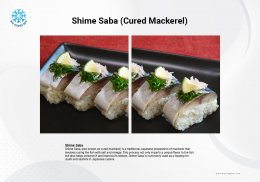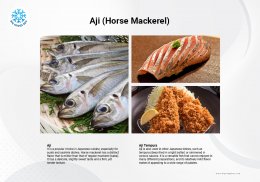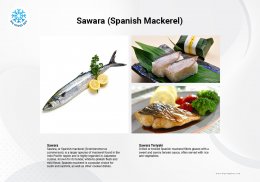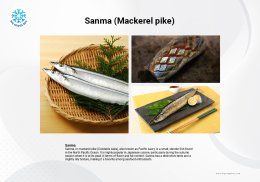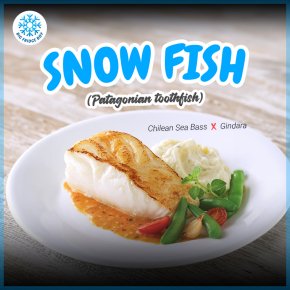'5 Mackerel' Most Use In Japanese Cuisine
Last updated: 28 Apr 2023 | 4758 Views |
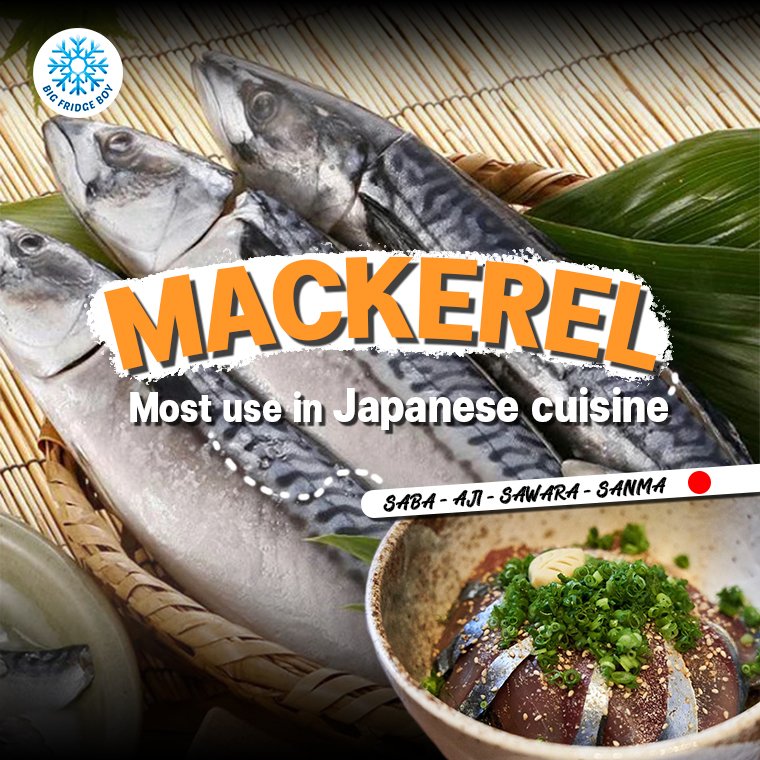
Mackerel is a popular and versatile fish in Japanese cuisine, appreciated for its rich flavor and numerous health benefits. The most well-known types of mackerel used in Japanese dishes are Saba (鯖, さば), Shime Saba (締め鯖, しめさば), Aji (鯵, あじ), Sawara (鰆, さわら), and Sanma (秋刀魚, さんま). These fish varieties are often enjoyed in sushi and sashimi, as well as various cooked dishes, each offering a unique taste and texture that cater to different preferences.
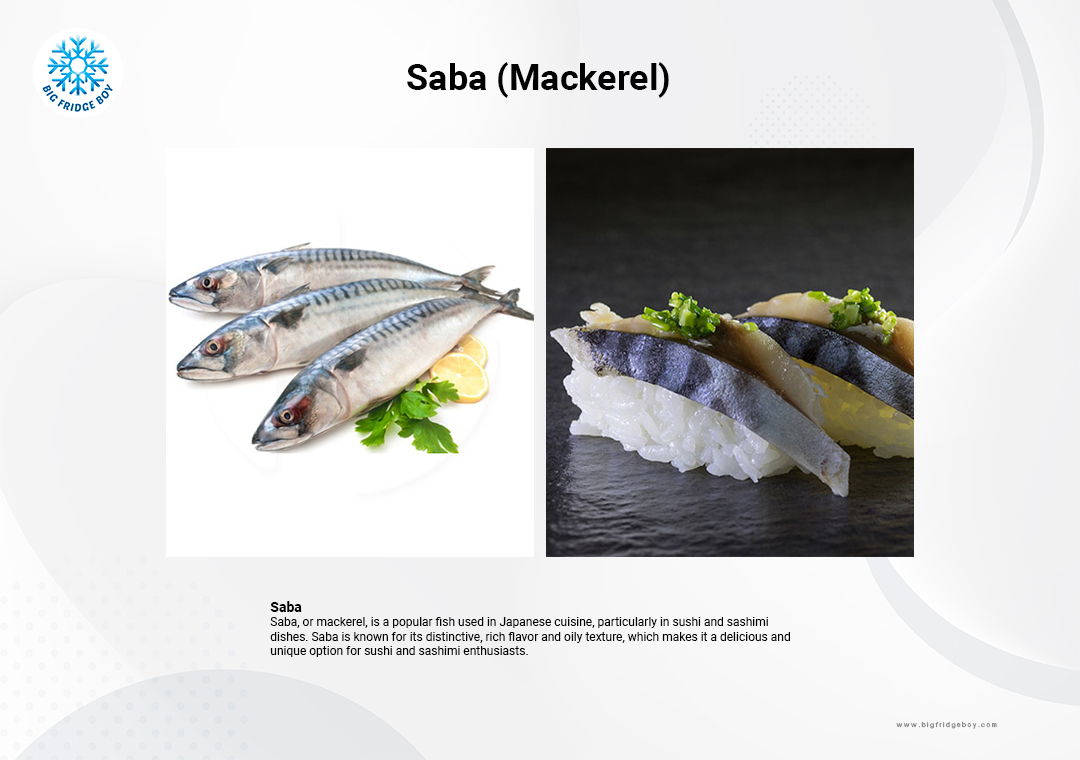
Saba (Mackerel): 鯖 (さば)
Saba, or mackerel, is a popular fish used in Japanese cuisine, particularly in sushi and sashimi dishes. Saba is known for its distinctive, rich flavor and oily texture, which makes it a delicious and unique option for sushi and sashimi enthusiasts.
In sushi, saba is typically served as "nigiri," which consists of a slice of fish placed on top of a small bed of vinegared rice. Saba nigiri is often slightly cured with salt or vinegar, and it might be garnished with grated ginger or green onions to balance out the strong taste.
In sashimi, saba is sliced thinly and served raw, without rice. It's usually accompanied by soy sauce, wasabi, and pickled ginger, which help to enhance the flavor and cut through the oily texture of the fish.
The high-fat content in mackerel is a source of omega-3 fatty acids, which are known to provide several health benefits, such as reducing inflammation and promoting heart health. However, because saba has a strong taste and is quite oily, it may not be to everyone's liking.
Atlantic and Pacific mackerel are two different species of mackerel fish found in their respective oceanic regions. While they share similarities in appearance and taste, there are some differences between them:
Scientific name and classification:
- Atlantic mackerel (Scomber scombrus) belongs to the Scombridae family, along with other mackerels, tunas, and bonitos.
- Pacific mackerel (Scomber japonicus), also known as Chub mackerel or Blue mackerel, is a different species in the same family.
Distribution and habitat:
- Atlantic mackerel is found in the Atlantic Ocean, predominantly along the coastlines of Europe and North America.
- Pacific mackerel, as its name implies, inhabits the Pacific Ocean and is commonly found along the coastlines of Asia and North America.
Size and appearance:
- Both Atlantic and Pacific mackerel have a strong, rich flavor and an oily texture due to their high-fat content. They are both used in various cuisines worldwide, including Japanese dishes like sushi and sashimi. The taste of both species is quite similar, but some people might find slight differences in flavor and texture depending on the specific fish and its preparation.
In summary, Atlantic and Pacific mackerel are two distinct species within the same family, with differences in distribution, size, and appearance. Their taste and culinary uses are quite similar, making them both suitable for dishes like sushi and sashimi.

Shime Saba (Cured Mackerel): 締め鯖 (しめさば)
Shime Saba, also known as cured mackerel, is a traditional Japanese preparation of mackerel that involves curing the fish with salt and vinegar. This process not only imparts a unique flavor to the fish but also helps preserve it and improve its texture. Shime Saba is commonly used as a topping for sushi and sashimi in Japanese cuisine. Here is a basic method for preparing Shime Saba:
- Filleting
First, the mackerel is filleted and deboned, resulting in two clean fillets. - Salting
The fillets are then generously coated with salt and left to cure for a certain period, usually between 30 minutes and 2 hours. This process draws out excess moisture and firms up the flesh. - Rinsing
After the salting process, the fillets are rinsed thoroughly with cold water to remove the excess salt. - Vinegar cure
The rinsed fillets are then submerged in a mixture of rice vinegar (or another mild vinegar) and a sweetener like sugar or mirin for about 30 minutes to a few hours, depending on the desired level of acidity and flavor. - Resting
Once the curing process is complete, the fillets are removed from the vinegar mixture, patted dry, and allowed to rest in the refrigerator for a few hours or overnight to let the flavors meld. - Slicing and serving
The Shime Saba is then sliced and served as sushi or sashimi, typically accompanied by soy sauce, wasabi, and pickled ginger.
Shime Saba has a distinct flavor profile, characterized by its tangy, slightly acidic taste resulting from the vinegar cure. The curing process also gives the fish a firmer texture compared to fresh mackerel.
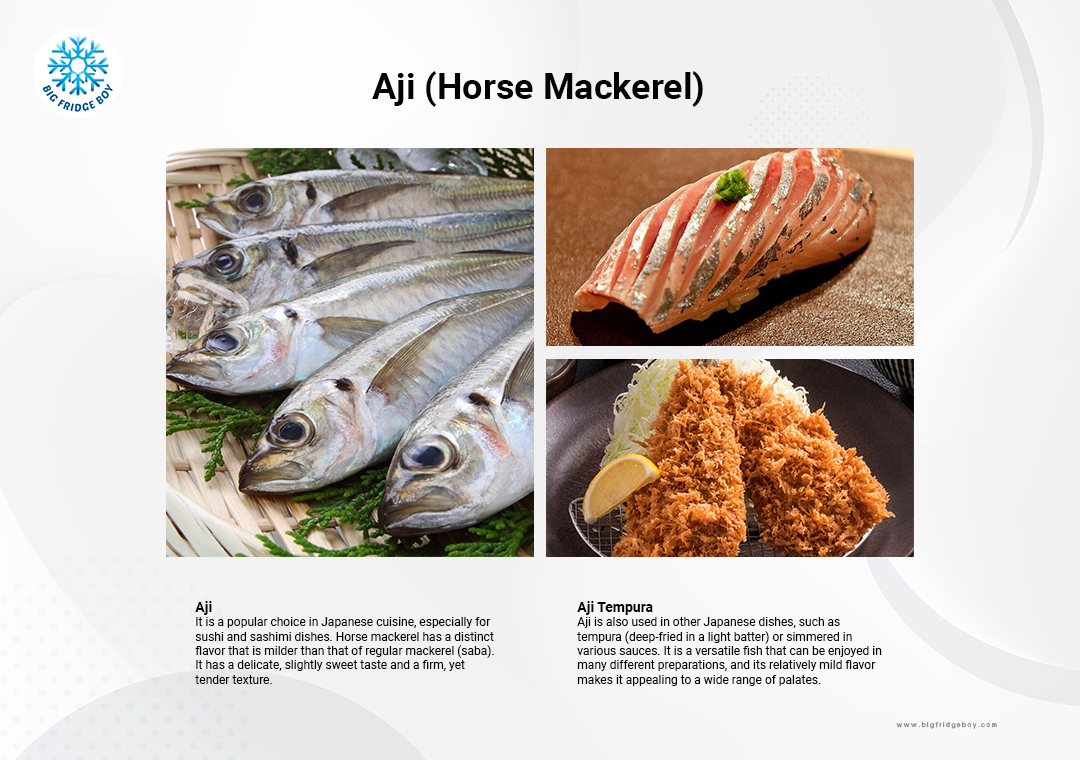
Aji (Horse Mackerel): 鯵 (あじ)
Aji, or horse mackerel (Trachurus japonicus), is a small fish species found in the waters of the Northwest Pacific, particularly near the coasts of Japan, Korea, and China. It is a popular choice in Japanese cuisine, especially for sushi and sashimi dishes. The name "aji" actually refers to a few species of fish within the Carangidae family, but Trachurus japonicus is the most commonly used for culinary purposes in Japan.
Aji is smaller and more slender than regular mackerel. They have a bluish-green back, a silver-white belly, and a series of small, dark spots along their lateral line. Horse mackerel can grow up to 14 inches (35 cm) in length.
Horse mackerel has a distinct flavor that is milder than that of regular mackerel (saba). It has a delicate, slightly sweet taste and a firm, yet tender texture. Aji is often enjoyed as:
- Aji Sashimi: Thinly sliced raw horse mackerel, typically served with soy sauce, wasabi, and sometimes grated ginger or minced green onions.
- Aji Nigiri: A small slice of horse mackerel placed on top of a bed of vinegared sushi rice, usually garnished with grated ginger, green onions, or a touch of wasabi.
- Aji Tataki: Lightly seared horse mackerel, served with a citrusy soy sauce or ponzu sauce.
- Aji no Hiraki: Butterflied and grilled horse mackerel, seasoned with salt or a light soy sauce glaze.
Aji is also used in other Japanese dishes, such as tempura (deep-fried in a light batter) or simmered in various sauces. It is a versatile fish that can be enjoyed in many different preparations, and its relatively mild flavor makes it appealing to a wide range of palates.
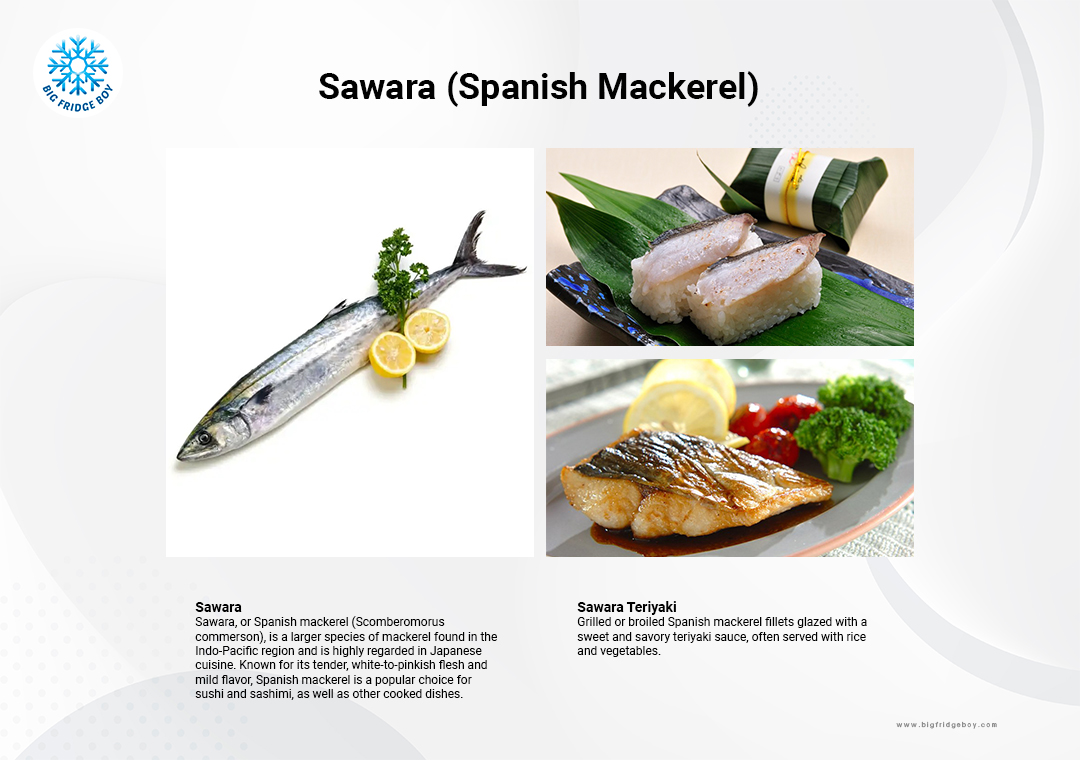
Sawara (Spanish Mackerel): 鰆 (さわら)
Sawara, or Spanish mackerel (Scomberomorus commerson), is a larger species of mackerel found in the Indo-Pacific region and is highly regarded in Japanese cuisine. Known for its tender, white-to-pinkish flesh and mild flavor, Spanish mackerel is a popular choice for sushi and sashimi, as well as other cooked dishes.
Sawara is larger than both Saba and Aji, with a more elongated body shape. Its back is dark blue or greenish-blue, while its belly is silver-white. The body is adorned with a few rows of bronze or yellowish spots along the sides. Spanish mackerel can grow up to 39 inches (100 cm) in length.
Here are some common ways sawara is used in Japanese cuisine:
- Sawara Sashimi: Thinly sliced raw Spanish mackerel served with soy sauce, wasabi, and pickled ginger. The mild flavor and delicate texture of the fish make it a delicious option for sashimi.
- Sawara Nigiri: A small slice of Spanish mackerel placed on top of a bed of vinegared sushi rice, usually brushed with a light soy sauce glaze or garnished with grated ginger and a touch of wasabi.
- Sawara Teriyaki: Grilled or broiled Spanish mackerel fillets glazed with a sweet and savory teriyaki sauce, often served with rice and vegetables.
- Sawara Shioyaki: Salt-grilled Spanish mackerel fillets, typically served with a side of grated daikon radish and a wedge of lemon.
- Sawara no Misozuke: Spanish mackerel marinated in miso paste and then grilled or broiled, resulting in a rich, savory, and slightly sweet dish.
While sawara is not as rich and oily as other mackerel varieties, such as saba, it is still a good source of omega-3 fatty acids and other essential nutrients. Its mild taste and versatile nature make it a popular choice for a variety of dishes in Japanese cuisine.
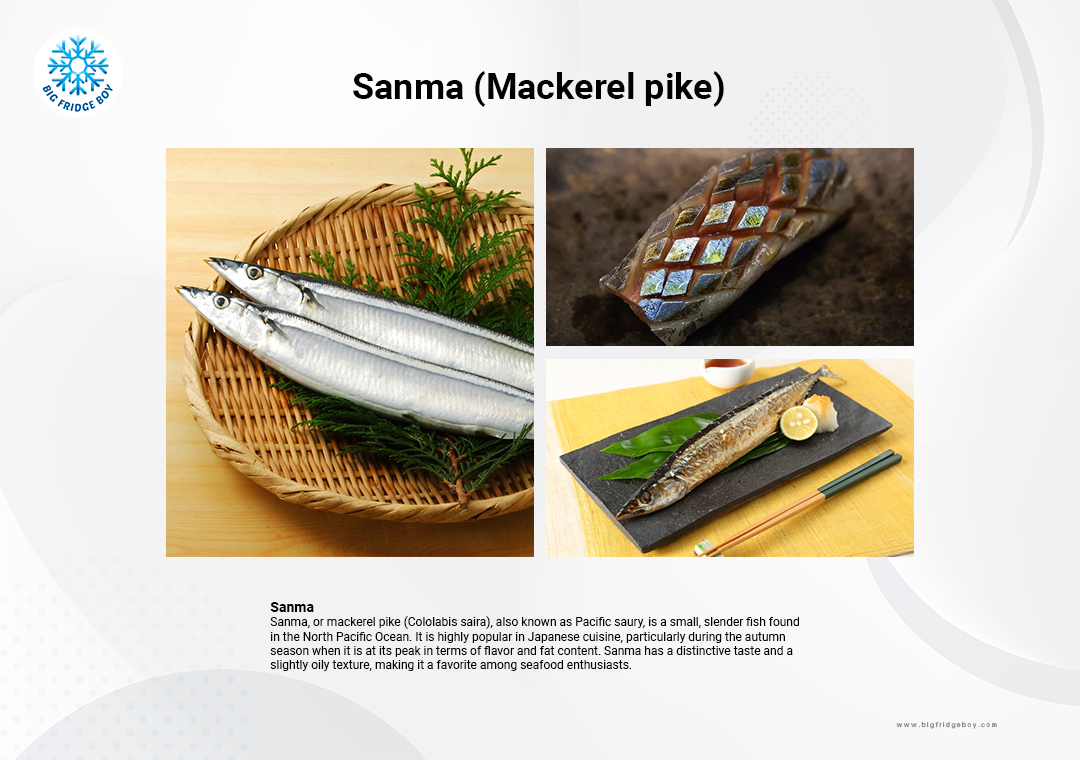
Sanma (Mackerel pike): 秋刀魚 (さんま)
Sanma, or mackerel pike (Cololabis saira), also known as Pacific saury, is a small, slender fish found in the North Pacific Ocean. It is highly popular in Japanese cuisine, particularly during the autumn season when it is at its peak in terms of flavor and fat content. Sanma has a distinctive taste and a slightly oily texture, making it a favorite among seafood enthusiasts.
Sanma is a small, slender fish with a more elongated and narrow body shape compared to other mackerel varieties. They have a bluish-green back, silvery-white belly, and a row of small, dark spots along their lateral line. Mackerel pike can grow up to 18 inches (45 cm) in length.
Here are some common ways sanma is used in Japanese cuisine:
- Sanma Shioyaki: The most traditional and popular method of preparing sanma, where the whole fish is salted and then grilled over charcoal or broiled. The skin becomes crispy, while the flesh remains moist and flavorful. It is often served with grated daikon radish, a slice of lemon, and a bowl of rice.
- Sanma Sashimi: Although not as common as other types of sashimi, sanma can be served raw, thinly sliced, and accompanied by soy sauce, wasabi, and pickled ginger. Its strong flavor and slightly oily texture can be appealing for those who enjoy more assertive-tasting fish.
- Sanma Nitsuke: Sanma is simmered in a mixture of soy sauce, sake, mirin, sugar, and ginger, resulting in a tender and flavorful dish with a slightly sweet and savory sauce.
- Sanma no Nanbanzuke: The fish is first fried, then marinated in a mixture of vinegar, soy sauce, sugar, and vegetables like sliced onion, carrot, and chili pepper, creating a tangy and refreshing dish.
- Sanma Tempura: Sanma can be coated in a light tempura batter and deep-fried until golden and crispy. It is typically served with tentsuyu dipping sauce or a sprinkle of salt.
Sanma is rich in omega-3 fatty acids, vitamins, and minerals, making it a nutritious choice in addition to its unique taste. The distinctive flavor and various preparations make it an interesting addition to the wide range of seafood dishes in Japanese cuisine.
Key highlight
- Saba, or mackerel, is celebrated for its rich, oily taste and is commonly used in sushi, sashimi, and grilled or simmered dishes.
- Shime Saba, a cured mackerel preparation, is made by preserving the fish with salt and vinegar, resulting in an enhanced flavor and improved texture that is perfect for sushi and sashimi.
- Aji, or horse mackerel, is a smaller, more delicate fish with a slightly sweet flavor and tender texture, often featured in sushi, sashimi, and grilled or seared dishes.
- Sawara, or Spanish mackerel, is prized for its tender, mildly flavored white-to-pinkish flesh, making it a popular choice for sushi, sashimi, and various cooked preparations such as teriyaki or shioyaki (salt-grilled).
- Lastly, Sanma, or mackerel pike, is a slightly oily fish with a distinctive taste, enjoyed during the autumn season in dishes like shioyaki, nitsuke (simmered in soy sauce), and tempura.
Each of these mackerel varieties adds a distinct and delicious element to Japanese cuisine, providing a range of flavors and textures that seafood enthusiasts can enjoy.


